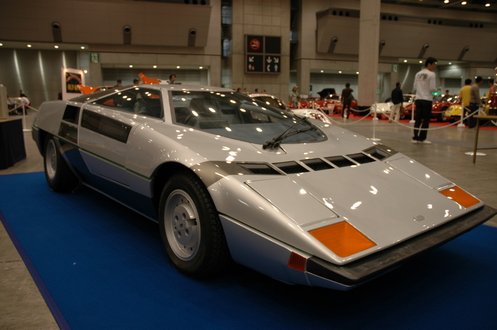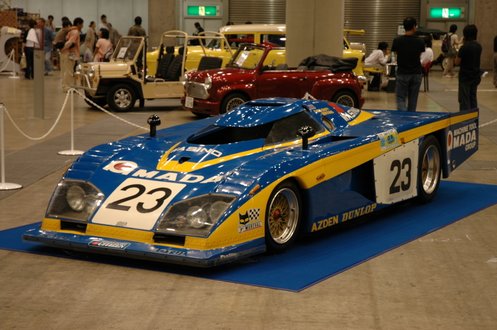 Ask anyone to name Japan’s first mid engined supercar and most people would nominate the Honda NSX. Change tack and instead ask about JDM prototype mid engined supercars and the extremely well-informed would say, ok, Nissan Mid-4. However. Japan’s very first mid engined supercar, and certainly the one which had the highest international profile is the Dome Zero.
Ask anyone to name Japan’s first mid engined supercar and most people would nominate the Honda NSX. Change tack and instead ask about JDM prototype mid engined supercars and the extremely well-informed would say, ok, Nissan Mid-4. However. Japan’s very first mid engined supercar, and certainly the one which had the highest international profile is the Dome Zero.
Dome, in Japanese, means “a child’s dream” and it’s a fitting name for such a fanciful car. Today, Dome is a race engineering company, with a long history of involvement in JGTC, touring cars and open wheelers. In the 1980s they were well known in Le Mans circles, eventually partnering with Toyota in many Le Mans campaigns in that decade. But when they first started out in the mid 70s, Dome was a Japanese company with ambitions to build Japan’s first supercar, the Dome Zero. It was a very small, low wedge and the prototype debuted to wild acclaim at the Geneva motor show in 1978.
After all, the Japanese had never done an Italian style supercar concept before, and the Dome Zero certainly could hold its own stylistically alongside Euro concept cars of the time. The Dome especially has some strong Bertone influences, which can be seen in concepts like the Alfa Carabo and Navajo, as well as the original Lancia Stratos and Lamborghini Bravo concepts. So it was much admired for its contemporary 70’s wedge look, which still managed to incorporate enough character to be distinctly Japanese.

The car was powered by a 150hp 2.8 six from the Datsun 280ZX, and while that isn’t a lot, it only weighed 920kg. Compare that to a Porsche 911 of the time, which weighed 1100kg and had 180ps, then you realise that the Zero actually would have had a reasonably competitive power to weight ratio for a hi-end sports car of the late 1970s. The development of the prototype began 3yrs before that fateful 1978 Geneva Motor Show, and it’s quite a sensational story, as told here in the Dome website.

In a weird twist of fate, the Dome Zero prototype made such an impression that Dome was approached by a JDM toy manufacturer, and the subsequent licensing of the Dome Zero shape into radio controlled and die-cast toys made the company so much money in royalties (hey…even I had a Tomica Dome Zero when I was a kid!) that it was enough for them to go and build a factory for manufacturing the roadcars. The early success of those toy cars were so integral to the company’s survival, that to this day, Dome maintains a museum of Dome toys in its company HQ in Shiga.
Only in Japan….
So now Dome had a factory in Kyoto, but due to the strict type-approval system in Japan, there was no way that a small company like Dome could homologate the Zero for the Japanese market. Frustrated with Japanese red tape, they instead they looked into building the Zero in the USA, where where homologation requirements were thought to be more relaxed than Japan. This explains why the the Dome P2 prototypes (the red ones in this article) have a much bigger and more ungainly, front bumper to satisfy 70s US bumper regulations. The plan was that the completed US Domes would be imported back into Japan for sale (this is exactly what Tommy Kaira did decades later with the ZZ roadster, which was built in the UK).
However, it never really worked out so the only Dome Zeros that exist are a handful of running pre-production prototypes.

Due to the positive publicity from the Zero project (and also in no small part to the increasing toy royalties flooding in), Dome managed to realise its dream to race Le Mans and it did so a few yrs later, and shelved the road car project, indefinitely. Their first Le Mans racer was, for old time’s sake, named the Dome Zero RL. And it certainly looks Japanese, check out that mecha-inspired cockpit!







You’ve forgotten the Tom Tjaarda designed Isuzu Bellett MX1600!!
From Wikipedia:
MX1600
At the 1969 Tokyo Motor Show, Isuzu presented a concept car called Isuzu Bellett MX1600, designed by Tom Tjaarda. It was a mid-engined, rear-wheel drive 2-seater super sports car. Apart from sharing the 1.6 L engine (140hp) with the GT-R, the MX1600 had little to do with any production Bellett, and it never materialized into a production vehicle, but it is said to have inspired the De Tomaso Pantera by the same stylist.
Ahh. I stand corrected! 🙂
Good call
Pingback: The Japanese supercar that almost was - the Dome Zero | Review Cars Blog